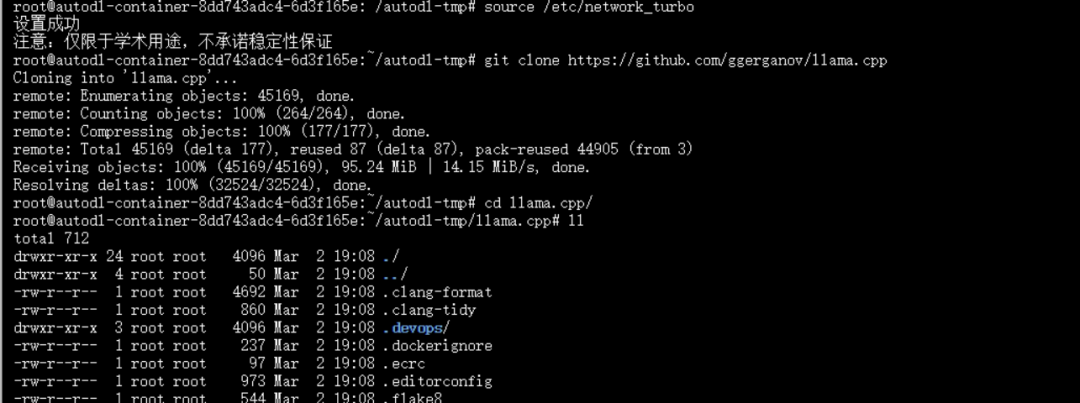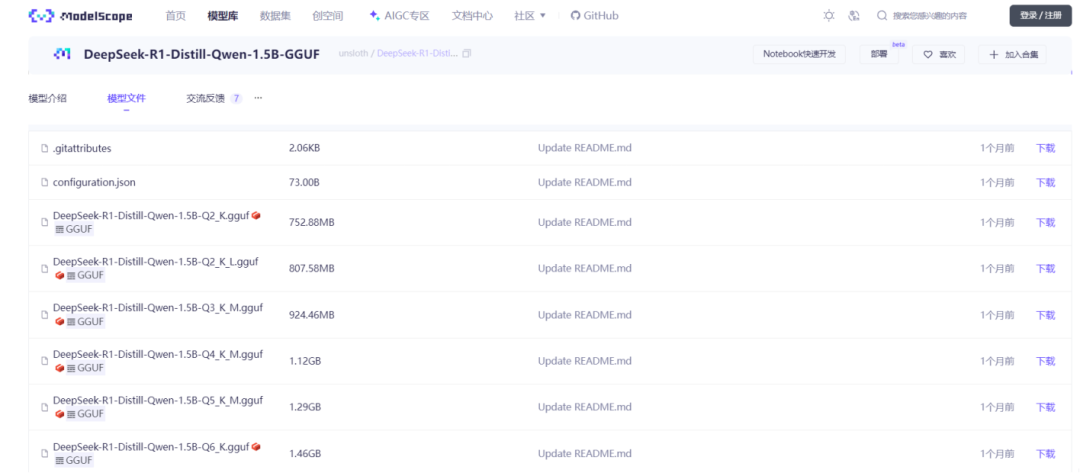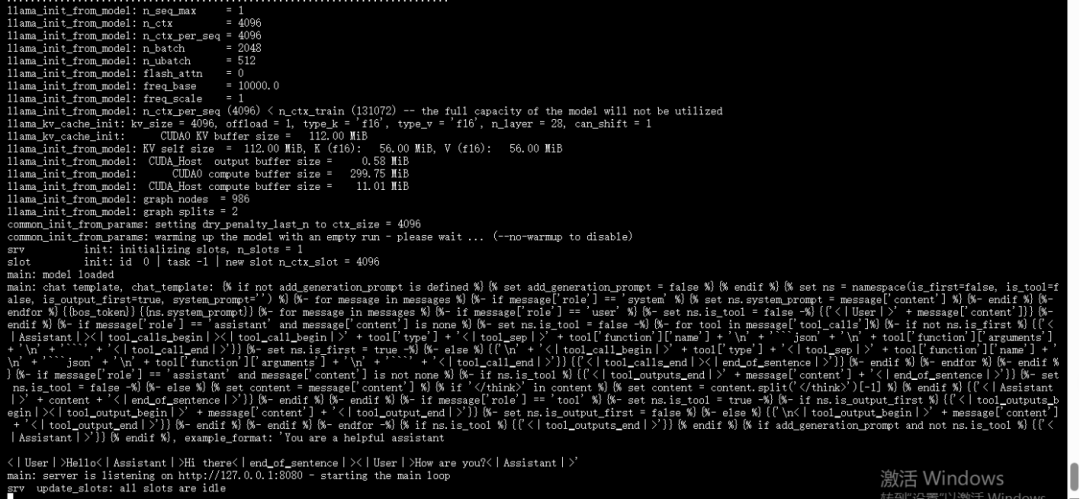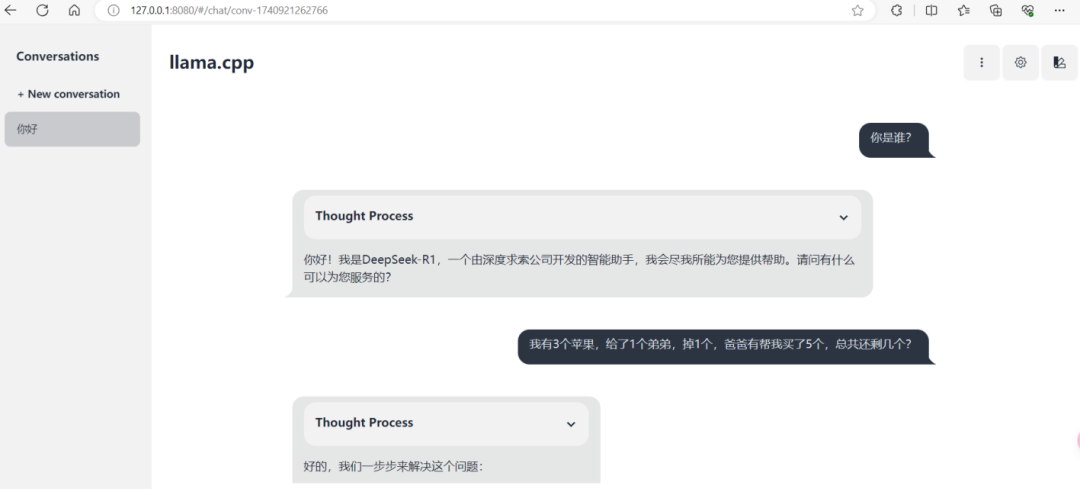
在当今快速发展的 AI 领域,本地运行大型语言模型(LLM)的需求日益增长。llama.cpp 是一个高性能的 C/C++ 库,专门用于运行 LLM,支持多种硬件加速选项。本文将详细介绍如何使用 llama.cpp 在本地运行 DeepSeek-R1 蒸馏模型(1.5B-GGUF),帮助您在消费级硬件上实现高效推理。
一、环境准备
在开始之前,需要确保开发环境已经准备好。这包括安装必要的工具和库,以及配置好适合的硬件环境。
1.下载llama.cpp
首先,需要从 GitHub 克隆 llama.cpp 仓库。llama.cpp 提供了简洁的 API 和高效的内存管理,非常适合在本地运行复杂的模型。
git clone https://github.com/ggerganov/llama.cppcd llama.cpp
执行如下:

2. 编译llama.cpp
根据您的硬件配置,选择合适的编译命令。`llama.cpp`支持CPU和GPU两种运行模式,您可以根据需求选择。
CPU 构建(适用于无GPU环境):
如果您的设备没有GPU,或者您希望仅使用CPU进行推理,可以使用以下命令进行编译:
cmake -B buildcmake --build build --config Release
这将生成适用于CPU的可执行文件。
GPU 构建(支持CUDA加速):
如果您的设备支持CUDA,并且您希望利用GPU加速模型推理,可以使用以下命令:
cmake -B build -DGGML_CUDA=ONcmake --build build --config Release
执行如下:

3. 安装依赖
为了运行模型并使用相关的功能,您需要安装一些Python依赖。这些依赖将帮助您下载模型文件,并在Python环境中与模型进行交互。
# 使用`modelscope`库可以方便地下载模型文件,我们需要先安装modelscope:pip install modelscope#安装openai,方便后面代码使用openai风格的API接口pip install openai==0.28
在运行模型之前,需要获取模型文件。`DeepSeek-R1`蒸馏模型是一个经过优化的版本,适合在本地运行,同时保持较高的推理性能。

我们从modelscope仓库下载DeepSeek-R1蒸馏版模型。下面我们以Q6_K量化为例,展示如何下载模型文件。
modelscope download --model unsloth/DeepSeek-R1-Distill-Qwen-1.5B-GGUF DeepSeek-R1-Distill-Qwen-1.5B-Q6_K.gguf --local_dir /root/autodl-tmp/models下载完成后,模型文件将保存到`models`目录。

直接下载:如果你喜欢直接下载文件,可以通过以下链接手动下载GGUF文件,并将其保存到`models`目录:
二、启动模型服务(一键启动)
在下载并准备好了模型文件之后,接下来需要启动模型服务。`llama.cpp`提供了一个轻量级的HTTP服务器,可以方便地运行和访问模型。
根据您的操作系统和硬件配置,选择合适的命令启动模型服务:
-
Windows示例(使用预编译二进制):
如果您使用的是Windows系统,并且已经下载了预编译的二进制文件,可以使用以下命令启动服务器:
start cmd.exe /k "llama-server.exe -m models/DeepSeek-R1-Distill-Qwen-1.5B-Q6_K.gguf -c 15000 -ngl 999"-
Linux/Mac示例(源码编译后):
如果您使用的是Linux或Mac系统,并且已经从源码编译了`llama.cpp`,可以使用以下命令启动服务器:
./build/bin/llama-server -m /root/autodl-tmp/models/DeepSeek-R1-Distill-Qwen-1.5B-Q6_K.gguf --port 8080 -ngl 40启动完成如下:

关键参数说明:
-
`-c 15000`:设置上下文长度(根据内存调整)。上下文长度决定了模型在推理时可以处理的最大文本长度。
-
`-ngl 999`:设置GPU层数(设为`0`则纯CPU运行)。如果您希望利用GPU加速,可以根据您的硬件配置调整这个参数。
-
`–host 127.0.0.1`:绑定本地端口。这将使服务器仅在本地运行,确保安全性。
在启动服务后,您可以通过以下方式验证模型是否正常运行
使用验证(一):浏览器界面体验
打开浏览器并访问`http://127.0.0.1:8080`,您应该能够看到一个简单的Web界面,用于测试模型的推理功能。

使用验证(二):bash脚本调用API
在命令行窗口,可以使用以下脚本:
curl http://localhost:8080/v1/chat/completions \-H "Content-Type: application/json" \-d '{"model": "DeepSeek-R1-Distill-Qwen-1.5B","messages": [{"role": "user", "content": "请介绍一下deepseek"}],"temperature": 0}'
模型返回如下:
{"choices":[{"finish_reason":"stop","index":0,"message":{"role":"assistant","content":"<think>\n\n</think>\n\n深度求索人工智能基础技术研究有限公司(简称“深度求索”或“DeepSeek”),成立于2023年,是一家专注于实现AGI的中国公司。"}}],"created":1740921610,"model":"DeepSeek-R1-Distill-Qwen-1.5B","system_fingerprint":"b4798-1782cdfe","object":"chat.completion","usage":{"completion_tokens":42,"prompt_tokens":7,"total_tokens":49},"id":"chatcmpl-cmfV78hIDgvBQkL1kh6LivxpthPOgA3p","timings":{"prompt_n":5,"prompt_ms":24.283,"prompt_per_token_ms":4.8566,"prompt_per_second":205.90536589383518,"predicted_n":42,"predicted_ms":173.381,"predicted_per_token_ms":4.128119047619047,"predicted_per_second":242.24107601178906}}使用验证(三):Python脚本调用API
在Python环境中使用模型,可以使用以下脚本:
import openaiopenai.api_base = "http://127.0.0.1:8080/v1"openai.api_key = "EMPTY" # Not usedresponse = openai.Completion.create(model="local",prompt="What is 1+1?")print(response.choices[0].text)
这将调用模型并输出推理结果,如下:
*and* 1+1.Wait, no, that's just one question. Maybe I should try another approach. Wait, perhaps I'm overcomplicating things.Actually, I need to solve the equation: 1+1=10 in some base. Hmm, okay, so let's think about number bases. In base 10, we know that 1+1=2. But in other bases, the representation changes. So, if I have the equation 1+1=10 in some base, what would that base be?Wait, so 10 in base b is equal to 1*b + 0 = b in base 10. Similarly, 1+1=2 in base 10. So, in the equation, 1+1=10 in base b translates to 2 = b in base 10. So, solving for b, we get b=2. So, the base is 2. Hmm, that seems straightforward, but maybe I'm missing something.Alternatively, maybe the equation isn't 1+1=10 in base b, but perhaps 1+1=10 in base 10? No, that doesn't make sense because in base 10, 1+1=2, which isn't 10. So, that can't be. So, I think my initial reasoning is correct.But just to double-check, let's see: if in base b, 1+1 equals 10, then in base 10, this would mean 1*b + 1 = 1*b + 0? Wait, no, 10 in base b is equal to 1*b + 0. So, 1+1=2, but 10 in base b is equal to b. So, 2 must equal b. Therefore, b is 2.But, just to make sure I haven't overlooked something, let me think about another approach. In base b, the digits must satisfy 0 ≤ digit < b. So, in the equation 1+1=10, the digits are 1,1, and 0. In base 2, the digits can only be 0 or 1, which is fine because the digits in the equation are 1 and 0. So, base 2 is acceptable.Another way to think about it: when adding 1 and 1 in base b, if the result is 10, which is equal to b in base 10. So, since 1+1=2 in base 10, that must be equal to b. Therefore, b=2.Alternatively, maybe we can consider that in base b, the number 10 represents b in base 10. So, 1+1=2, and in base b, 2 must equal 10, meaning that 2= b. Hence, b=2.So, after thinking through different angles, I'm confident that the base is 2.**Final Answer**The base is \boxed{2}.</think>To solve the equation \(1 + 1 = 10\) in some base, we need to determine the base \(b\) such that the equation holds true.1. In any base \(b\), the number \(10\) represents \(b\) in base 10.2. The equation \(1 + 1 = 10\) translates to \(1 + 1 = b\) in base 10.3. Simplifying this, we get \(2 = b\).Thus, the base \(b\) is 2. This is confirmed because in base 2, the number \(10\) represents 2 in base 10, and the addition \(1 + 1\) in base 2 results in 10.Therefore, the base is \(\boxed{2}\).
三、性能优化与问题排查
在运行模型时,您可能会遇到一些性能问题或错误。以下是一些优化建议和常见问题的解决方案:
1. 硬件适配建议
-
显存不足:如果您遇到显存不足的问题,可以尝试降低`-ngl`值(减少GPU层数),或者使用低量化版本(如`Q4_K_M`)。低量化版本可以在减少内存占用的同时,保持较高的推理性能。
-
内存限制:对于32GB内存的设备,建议运行`Q4`量化版。1.5B模型至少需要8GB内存。如果您的设备内存较小,建议选择更小的模型版本。
2. 常见错误解决
-
Tokenizer错误:如果您遇到Tokenizer相关的错误,请确保`llama.cpp`版本不低于`b4514`。更新到最新版本通常可以解决这类问题。
-
模型加载失败:如果模型加载失败,请检查GGUF文件的完整性,或者尝试重新下载模型文件。确保下载的文件与您选择的模型版本一致。
四、总结
通过`llama.cpp`运行DeepSeek-R1蒸馏版模型,您可以在消费级硬件上体验高性能推理。`llama.cpp`提供了灵活的配置选项,支持多种硬件加速方式,并且易于部署。建议优先使用预编译二进制文件以简化部署流程,并根据硬件配置调整量化参数与GPU层数。如果您需要更高的推理精度,可以尝试运行更大参数的模型;希望本指南能帮助您顺利运行DeepSeek-R1模型,享受高效、灵活的本地推理体验!
(文:小兵的AI视界)

